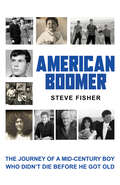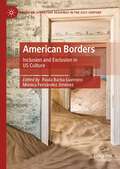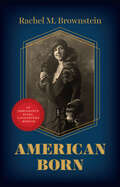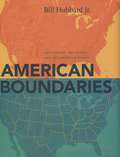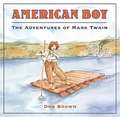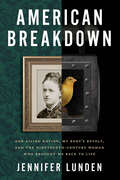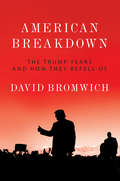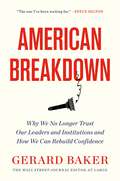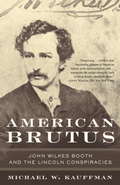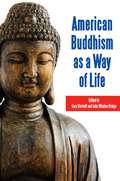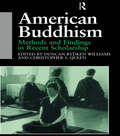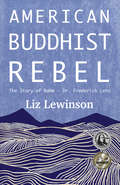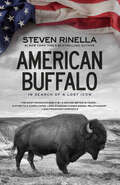- Table View
- List View
American Boomer
by Steve FisherOK, Boomer… this is the book you&’ve been waiting for! A memoir by one of your own, about your time and tribulations, which will take you down memory lane and may even remind you of yourself as a child of the Greatest Generation.As a front-line baby boomer, Steve Fisher was a youngster in the 1950s and came of age in the turbulent 1960s. Never one to stay within the proscribed parameters and never too big on rules, he followed his own path and made choices that were, unfortunately, often to his own detriment. American Boomer traces the highs and lows of his exceptional journey, including his time as a musician, a radio disc-jockey, and ultimately, a writer. Funny and poignant, uplifting and heart-breaking, American Boomer is a hard and honest look at a son of the Greatest Generation who didn&’t die before he got old.If you&’re a baby boomer, much of the vernacular in this book will be familiar to you. If you&’re a younger reader… that&’s why there&’s Google.
American Borders: Inclusion and Exclusion in US Culture (American Literature Readings in the 21st Century)
by Paula Barba Guerrero Mónica Fernández JiménezAmerican Borders: Inclusion and Exclusion in US Culture provides an overview of American culture produced in a range of contexts, from the founding of the nation to the age of globalization and neoliberalism, in order to understand the diverse literary landscapes of the United States from a twenty-first century perspective. The authors confront American exceptionalism, discourses on freedom and democracy, and US foundational narratives by reassessing the literary canon and exploring ethnic literature, culture, and film with a focus on identity and exclusion. Their contributions envision different manifestations of conviviality and estrangement and deconstruct neoliberal slogans, analyzing hospitable inclusion in relation to national history and ideologies. By looking at representations of foreignness and conditional belonging in literature and film from different ethnic traditions, the volume fleshes out a new border dialectic that conveys the heterogeneity of American boundaries beyond the opposition inside/outside.
American Born: An Immigrant's Story, a Daughter's Memoir (Emersion: Emergent Village Resources For Communities Of Faith Ser.)
by Rachel M. BrownsteinAn incisive memoir of Rachel M. Brownstein’s seemingly quintessential Jewish mother, a resilient and courageous immigrant in New York. When she arrived alone in New York in 1924, eighteen-year-old Reisel Thaler resembled the other Yiddish-speaking immigrants from Eastern Europe who accompanied her. Yet she already had an American passport tucked in her scant luggage. Reisel had drawn her first breath on the Lower East Side of Manhattan in 1905, then was taken back to Galicia (in what is now Poland) by her father before she turned two. She was, as she would boast to the end of her days, “American born.” The distinguished biographer and critic Rachel M. Brownstein began writing about her mother Reisel during the Trump years, dwelling on the tales she told about her life and the questions they raised about nationalism, immigration, and storytelling. For most of the twentieth century, Brownstein’s mother gracefully balanced her identities as an American and a Jew. Her values, her language, and her sense of timing inform the imagination of the daughter who recalls her in her own old age. The memorializing daughter interrupts, interprets, and glosses, sifting through alternate versions of the same stories using scenes, songs, and books from their time together. But the central character of this book is Reisel, who eventually becomes Grandma Rose—always watching and judging, singing, baking, and bustling. Living life as the heroine of her own story, she reminds us how to laugh despite tragedy, find our courage, and be our most unapologetically authentic selves.
American Boundaries: The Nation, The States, The Rectangular Survey
by Bill Hubbard Jr.For anyone who has looked at a map of the United States and wondered how Texas and Oklahoma got their Panhandles, or flown over the American heartland and marveled at the vast grid spreading out in all directions below, American Boundaries will yield a welcome treasure trove of insight. The first book to chart the country's growth using the boundary as a political and cultural focus, Bill Hubbard's masterly narrative begins by explaining how the original thirteen colonies organized their borders and decided that unsettled lands should be held in trust for the common benefit of the people. Hubbard goes on to show--with the help of photographs, diagrams, and hundreds of maps--how the notion evolved that unsettled land should be divided into rectangles and sold to individual farmers, and how this rectangular survey spread outward from its origins in Ohio, with surveyors drawing straight lines across the face of the continent. Mapping how each state came to have its current shape, and how the nation itself formed within its present borders, American Boundaries will provide historians, geographers, and general readers alike with the fascinating story behind those fifty distinctive jigsaw-puzzle pieces that together form the United States.
American Boy
by Don BrownOur popular image of Mark Twain is of a gruV, gray-haired eccentric, the outspoken literary giant who created enduring novels such as The Adventures of Tom Sawyer and The Adventures of Huckleberry Finn. But once upon a time, Mark Twain was a boy named Samuel Clemens. His birth on November 30, 1835, coincided with the appearance of Halley’s comet streaking across the sky. A dreamer, a prankster, a lover of great tales, Sam Clemens spent his boyhood years "in high feather,” living out adventures along the banks of the mighty Mississippi River. His beloved river would eventually carry Mark Twain far beyond Hannibal, Missouri, but he would return to the freedom, innocence, and vitality of his youth again and again in his writing. In glowing watercolors and spirited text, Don Brown reveals the glad morning of Twain’s life, now the classic American boyhood, and the forces that inspired his funny, irreverent, insightful, and groundbreaking works of fiction.
American Breakdown: Our Ailing Nation, My Body's Revolt, and the Nineteenth-Century Woman Who Brought Me Back to Life
by Jennifer LundenA Silent Spring for the human body, this wide-ranging, genre-crossing literary mystery interweaves the author’s quest to understand the source of her own condition with her telling of the story of the chronically ill 19th-century diarist Alice James—ultimately uncovering the many hidden health hazards of life in America.When Jennifer Lunden became chronically ill after moving from Canada to Maine, her case was a medical mystery. Just 21, unable to hold a book or stand for a shower, she lost her job and consigned herself to her bed. The doctor she went to for help told her she was “just depressed.”After suffering from this enigmatic illness for five years, she discovered an unlikely source of hope and healing: a biography of Alice James, the bright, witty, and often bedridden sibling of brothers Henry James, the novelist, and William James, the father of psychology. Alice suffered from a life-shattering illness known as neurasthenia, now often dismissed as a “fashionable illness.”In this meticulously researched and illuminating debut, Lunden interweaves her own experience with Alice’s, exploring the history of medicine and the effects of the industrial revolution and late-stage capitalism to tell a riveting story of how we are a nation struggling—and failing—to be healthy.Although science—and the politics behind its funding—has in many ways let Lunden and millions like her down, in the end science offers a revelation that will change how readers think about the ecosystems of their bodies, their communities, the country, and the planet.
American Breakdown: The Trump Years and How They Befell Us
by David BromwichHow Trump got to the Oval Office—and how both parties and the mainstream media are keeping him thereDonald Trump’s residency in the White House is not an accident of American history, and it can’t be blamed on a single cause. In American Breakdown, David Bromwich provides an essential analysis of the forces in play beneath the surface of our political system. His portraits of political leaders and overarching narrative bring to life the events and machinations that have led America to a collective breakdown.The political conditions of the present crisis were put in place over fifty years ago, with the expansion of the Vietnam War and the lies and coverups that brought down Nixon. Since then, every presidency has further centralized and strengthened executive power. The truly catastrophic event in American life was the invention by George W. Bush and Dick Cheney of the War on Terror, designed to last for generations. Barack Obama’s practice of “reconciliation without truth”—sparing CIA torturers and Wall Street bankers—deepened the distrust and anger of an electorate that has rallied around Trump.An unsparing account of the degradation of US democracy, American Breakdown is essential to our evaluation of its prospects. Arguing that Trump’s re-election seems just as likely as impeachment, Bromwich turns his attention to the new struggles within the Democratic Party on immigration, foreign policy, and the Green New Deal.American Breakdown will be a crucial reference point in the political debate around the upcoming presidential election—a contest in which the forces that created Donald Trump show no sign of letting up.
American Breakdown: Why We No Longer Trust Our Leaders and Institutions and How We Can Rebuild Confidence
by Gerard BakerFrom the former editor-in-chief of the Wall Street Journal, a must-read account of how America suffers from a &“trust deficit&” that has weakened its cornerstone institutions and divided our society. AMERICAN BREAKDOWN dissects how, in the space of a generation, the pillars that sustained the once-dominant superpower have been dangerously eroded. From government to business, from media to medicine—the strength and security of the American experiment have been weakened by a widening gap between the elites who control these institutions and the public. At the root of this breakdown is a precipitous fall in Americans&’ trust in their political, business and cultural leaders. As Baker writes, &“This pathology of distrust across American society is eating the country away from the inside.&” Millions of Americans say they have little faith in their country's future, and no longer seem to have trust in their leaders, in their important social and civil institutions, even in their common values and ideals, or ultimately in each other. America in fact hasn&’t failed. Americans have been failed—misled by inept and deceitful political leaders, deserted by predatory and cynical corporate chiefs, and, above all, betrayed by a cultural elite that has exploited the very freedom this country provided in order to destroy it. AMERICAN BREAKDOWN is a deep analysis and thought-provoking account that explores the ways in which Americans have been let down and offers solutions for how we rebuild trust and reclaim purpose for a better future.
American Brutus
by Michael W. KauffmanIt is a tale as familiar as our history primers: A deranged actor, John Wilkes Booth, killed Abraham Lincoln in Ford's Theatre, escaped on foot, and eluded capture for twelve days until he met his fiery end in a Virginia tobacco barn. In the national hysteria that followed, eight others were arrested and tried; four of those were executed, four imprisoned. Therein lie all the classic elements of a great thriller. But the untold tale is even more fascinating.Now, in American Brutus, Michael W. Kauffman, one of the foremost Lincoln assassination authorities, takes familiar history to a deeper level, offering an unprecedented, authoritative account of the Lincoln murder conspiracy. Working from a staggering array of archival sources and new research, Kauffman sheds new light on the background and motives of John Wilkes Booth, the mechanics of his plot to topple the Union government, and the trials and fates of the conspirators.Piece by piece, Kauffman explains and corrects common misperceptions and analyzes the political motivation behind Booth's plan to unseat Lincoln, in whom the assassin saw a treacherous autocrat, "an American Caesar." In preparing his study, Kauffman spared no effort getting at the truth: He even lived in Booth's house, and re-created key parts of Booth's escape. Thanks to Kauffman's discoveries, readers will have a new understanding of this defining event in our nation's history, and they will come to see how public sentiment about Booth at the time of the assassination and ever since has made an accurate account of his actions and motives next to impossible-until now.In nearly 140 years there has been an overwhelming body of literature on the Lincoln assassination, much of it incomplete and oftentimes contradictory. In American Brutus, Kauffman finally makes sense of an incident whose causes and effects reverberate to this day. Provocative, absorbing, utterly cogent, at times controversial, this will become the definitive text on a watershed event in American history.From the Hardcover edition.
American Brutus
by Michael W. KauffmanIt is a tale as familiar as our history primers: A deranged actor, John Wilkes Booth, killed Abraham Lincoln in Ford's Theatre, escaped on foot, and eluded capture for twelve days until he met his fiery end in a Virginia tobacco barn. In the national hysteria that followed, eight others were arrested and tried; four of those were executed, four imprisoned. Therein lie all the classic elements of a great thriller. But the untold tale is even more fascinating.Now, in American Brutus, Michael W. Kauffman, one of the foremost Lincoln assassination authorities, takes familiar history to a deeper level, offering an unprecedented, authoritative account of the Lincoln murder conspiracy. Working from a staggering array of archival sources and new research, Kauffman sheds new light on the background and motives of John Wilkes Booth, the mechanics of his plot to topple the Union government, and the trials and fates of the conspirators.Piece by piece, Kauffman explains and corrects common misperceptions and analyzes the political motivation behind Booth's plan to unseat Lincoln, in whom the assassin saw a treacherous autocrat, "an American Caesar." In preparing his study, Kauffman spared no effort getting at the truth: He even lived in Booth's house, and re-created key parts of Booth's escape. Thanks to Kauffman's discoveries, readers will have a new understanding of this defining event in our nation's history, and they will come to see how public sentiment about Booth at the time of the assassination and ever since has made an accurate account of his actions and motives next to impossible-until now.In nearly 140 years there has been an overwhelming body of literature on the Lincoln assassination, much of it incomplete and oftentimes contradictory. In American Brutus, Kauffman finally makes sense of an incident whose causes and effects reverberate to this day. Provocative, absorbing, utterly cogent, at times controversial, this will become the definitive text on a watershed event in American history.From the Hardcover edition.
American Brutus: John Wilkes Booth and the Lincoln Conspiracies
by Michael W. KauffmanIt is a tale as familiar as our history primers: A deranged actor, John Wilkes Booth, killed Abraham Lincoln in Ford's Theatre, escaped on foot, and eluded capture for twelve days until he met his fiery end in a Virginia tobacco barn. In the national hysteria that followed, eight others were arrested and tried; four of those were executed, four imprisoned. Therein lie all the classic elements of a great thriller. But the untold tale is even more fascinating. Now, in American Brutus, Michael W. Kauffman, one of the foremost Lincoln assassination authorities, takes familiar history to a deeper level, offering an unprecedented, authoritative account of the Lincoln murder conspiracy. Working from a staggering array of archival sources and new research, Kauffman sheds new light on the background and motives of John Wilkes Booth, the mechanics of his plot to topple the Union government, and the trials and fates of the conspirators. Piece by piece, Kauffman explains and corrects common misperceptions and analyzes the political motivation behind Booth's plan to unseat Lincoln, in whom the assassin saw a treacherous autocrat, "an American Caesar. " In preparing his study, Kauffman spared no effort getting at the truth: He even lived in Booth's house, and re-created key parts of Booth's escape. Thanks to Kauffman's discoveries, readers will have a new understanding of this defining event in our nation's history, and they will come to see how public sentiment about Booth at the time of the assassination and ever since has made an accurate account of his actions and motives next to impossible-until now. In nearly 140 years there has been an overwhelming body of literature on the Lincoln assassination, much of it incomplete and oftentimes contradictory. In American Brutus, Kauffman finally makes sense of an incident whose causes and effects reverberate to this day. Provocative, absorbing, utterly cogent, at times controversial, this will become the definitive text on a watershed event in American history. From the Hardcover edition.
American Buddhism as a Way of Life (SUNY series in Buddhism and American Culture)
by John Whalen-Bridge Gary StorhoffThe US seems to be becoming a Buddhist country. Celebrity converts, the popularity of the Dalai Lama, motifs in popular movies, and mala beads at the mall indicate an increasing inculcation of Buddhism into the American consciousness, even if a relatively small percentage of the population actually describe themselves as Buddhists. This book looks beyond the trendier manifestations of Buddhism in America to look at distinctly American Buddhist ways of life—ways of perceiving and understanding. John Whalen-Bridge and Gary Storhoff have organized this unique collection in accordance with the Buddhist concept of the Three Jewels: the Buddha, the Dharma, and the Sangha. The Buddha section discusses the two key teachers who popularized Buddhism in America: Alan Watts and D. T. Suzuki and the particular kinds of spirituality they proclaimed. The Dharma section deals with how Buddhism can enlighten current public debates and a consideration of our national past with explorations of bioethics, abortion, end-of-life decisions, and consciousness in late capitalism. The final section on the Sangha, or community of believers, discusses how Buddhist communities both formal and informal have affected American society with chapters on family life, Nisei Buddhists, gay liberation, and Zen gardens.
American Buddhism: Methods and Findings in Recent Scholarship (Routledge Critical Studies in Buddhism)
by Duncan Ryuken Williams Christopher QueenThis is the first scholarly treatment of the emergence of American Buddhist Studies as a significant research field. Until now, few investigators have turned their attention to the interpretive challenge posed by the presence of all the traditional lineages of Asian Buddhism in a consciously multicultural society. Nor have scholars considered the place of their own contributions as writers, teachers, and practising Buddhists in this unfolding saga. In thirteen chapters and a critical introduction to the field, the book treats issues such as Asian American Buddhist identity, the new Buddhism, Buddhism and American culture, and the scholar's place in American Buddhist Studies. The volume offers complete lists of dissertations and theses on American Buddhism and North American dissertations and theses on topics related to Buddhism since 1892.
American Buddhist Rebel: The Story of Rama - Dr. Frederick Lenz
by Liz LewinsonWinner of the 2016 Eric Hoffer Award, this acclaimed biography of the brilliant, controversial Buddhist teacher Rama - Dr. Frederick Lenz (1950 - 1998) is this free-spirited adventure of a wild, sports jock teenager who transforms into an iconoclastic, innovative leader, boundary breaking is de rigueur as reported by the 100+ students and colleagues interviewed by author Liz Lewinson. Meditation, the empowerment of women and career as practice are but three of the core teachings covered in this book. Dr. Lenz ran into opposition, of course, but he kept his priorities straight. When he visited Nepal at age 19, he encountered an aged monk who informed him that he was a lineage bearer. He was to revive an ancient school of enlightenment. He was to find his many past life students and help them achieve joyous enlightenment in this life or at least set them securely on the path. He was to do this in the West, using Western means. In the East, centuries-old traditions maintain meditative pathways to enlightenment. In the West, facing a blank canvas, Dr. Lenz found new ways to build mental/meditative prowess through careers such as computer science, visits to American "places of power," knowledge about real gender equilibrium, movies, music, and dance. He taught these skills to American students and observed their success. When you read this fast-paced biography, you enter the inner teaching circle of baseline American Buddhism. "This fascinating biography captures the wisdom of a genuine, compelling teacher who combined absolute miracles with humor, fun, and adventure. When you read this fast-paced book, you feel you are there, learning and transforming. This is an original and exciting read." -- Lynn Andrews, author of The Medicine Woman Series
American Buffalo: In Search of a Lost Icon
by Steven RinellaA hunt for the American buffalo—an adventurous, fascinating examination of an animal that has haunted the American imagination. In 2005, Steven Rinella won a lottery permit to hunt for a wild buffalo, or American bison, in the Alaskan wilderness. Despite the odds—there’s only a 2 percent chance of drawing the permit, and fewer than 20 percent of those hunters are successful—Rinella managed to kill a buffalo on a snow-covered mountainside and then raft the meat back to civilization while being trailed by grizzly bears and suffering from hypothermia. Throughout these adventures, Rinella found himself contemplating his own place among the 14,000 years’ worth of buffalo hunters in North America, as well as the buffalo’s place in the American experience. At the time of the Revolutionary War, North America was home to approximately 40 million buffalo, the largest herd of big mammals on the planet, but by the mid-1890s only a few hundred remained. Now that the buffalo is on the verge of a dramatic ecological recovery across the West, Americans are faced with the challenge of how, and if, we can dare to share our land with a beast that is the embodiment of the American wilderness. American Buffalois a narrative tale of Rinella’s hunt. But beyond that, it is the story of the many ways in which the buffalo has shaped our national identity. Rinella takes us across the continent in search of the buffalo’s past, present, and future: to the Bering Land Bridge, where scientists search for buffalo bones amid artifacts of the New World’s earliest human inhabitants; to buffalo jumps where Native Americans once ran buffalo over cliffs by the thousands; to the Detroit Carbon works, a “bone charcoal” plant that made fortunes in the late 1800s by turning millions of tons of buffalo bones into bone meal, black dye, and fine china; and even to an abattoir turned fashion mecca in Manhattan’s Meatpacking District, where a depressed buffalo named Black Diamond met his fate after serving as the model for the American nickel. Rinella’s erudition and exuberance, combined with his gift for storytelling, make him the perfect guide for a book that combines outdoor adventure with a quirky blend of facts and observations about history, biology, and the natural world. Both a captivating narrative and a book of environmental and historical significance,American Buffalotells us as much about ourselves as Americans as it does about the creature who perhaps best of all embodies the American ethos.
American Bulk: Essays on Excess
by Emily MesterRaised with hoarding and compulsive shopping, Emily Mester is caught in between. What happens when consumption begins to consume you back? In a series of deeply personal essays, Mester explores how the things we buy, eat, amass, and discard become an intimate part of our lives. We guiltily watch Amazon boxes pile up on the porch, wade through endless reviews to find the perfect product, and crave the comforting indulgence of a chain restaurant. With humor and sharp intellect, Mester reflects on the joys and anxieties of Costco trips, how a seasonal stint at Ulta Beauty taught her the insidious art of the sale, and what it means to get “mall sad.” In a nuanced examination of diet culture and fatness, Mester recounts her teenage summer at fat camp and the unexpected liberation she finds there. Finally, she ventures to Storm Lake, Iowa, to reckon with her grandmother’s abandoned hoard, excavating the dysfunction that lies at the heart of her family’s obsession with stuff. American Bulk introduces readers to a striking new literary talent from the American heartland, one who dares to ask us to regard consumption not with guilt but with grace and empathy.
American Bulldog
by Wil Deveer Abe FishmanOnce a well-kept secret in the United States, the American Bulldog is now one of the nation's most celebrated canine exports, establishing a devoted following around the globe. This Comprehensive Owner's Guide is dedicated to the American Bulldog, a breed that was once used as a ranch and farm dog but today excels as a companion and protection dog. Author Abe Fishman provides a controversial but wholly candid retelling of the breed's history and its re-creation in the United States. The history chapter is followed by a chapter devoted to the characteristics of this exceptional working breed, offering sound advice about which owners are best suited to this vigorous and active canine.New owners will welcome the well-prepared chapter on finding a reputable breeder and selecting a healthy, sound puppy. Chapters on puppy-proofing the home and yard, purchasing the right supplies for the puppy as well as house-training, feeding, and grooming are illustrated with photographs of handsome adults and puppies. In all, there are over 135 full-color photographs in this useful and reliable volume. The author's advice on obedience training will help the reader better mold and train into the most well-mannered dog in the neighborhood. The extensive and lavishly illustrated chapter on healthcare provides up-to-date detailed information on selecting a qualified veterinarian, vaccinations, preventing and dealing with parasites, infectious diseases, and more. Sidebars throughout the text offer helpful hints, covering topics as diverse as historical dogs, breeders, or kennels, toxic plants, first aid, crate training, carsickness, fussy eaters, and parasite control. Fully indexed. .
American Bureaucracy
by Warren G BennisLike it or not, contemporary man is man-in-bureaucracy. He spends the majority of his waking hours in a bureaucracy; establishes an identity and status in a bureaucracy; garners most of his satisfactions and disappointments in a bureaucracy; and, increasingly, he is what he does.Aside from the importance of understanding those institutions that shape our values, behavior, and experience, bureaucracy is a vital area for study because it reveals a wide range of social behavior in a compact and comprehensible way. The abstract and ephemeral problems of society at large are brought down to earth —made measurable, comprehensible and visible in the bureaucratic microcosm. Problems of power and influence, change and innovation, intergroup conflict, ambition and aspiration, self-realization versus participative democracy, technology versus humanism: all can be observed and analyzed in human organizations.This volume pinpoints the dilemma of present bureaucratic organizations: the conflict between the need to sustain innovation and bureaucratic drives toward rationality and stability. The essays it contains discuss specific human needs that bureaucracy must meet if it is to continue to attract talented people and takes a step into the future to analyze the kinds of organizations that may be expected to evolve as institutions seek more flexible use of human resources.
American Burger Revival: Brazen Recipes to Electrify a Timeless Classic
by Samuel Monsour Richard ChudyBold new burgers are appearing on the menus of the country's top restaurants, reverently prepared by some of the nation's best chefs. The burger has become a fine dining event, expertly crafted and fiendishly devoured. Allow award-winning chef Samuel Monsour and noted burger critic and chef Richard Chudy to serve as your guides in this brave new world, bringing that energy and creativity to your own kitchen and backyard. With a fearless do-it-yourself spirit and respect for the gritty, authentic flavors of American cuisine, Monsour and Chudy share 120 mouthwatering recipes to set your grills ablaze. No top-down, ordinary themed burgers here. Instead, these renegade chefs provide you with the inspiration to realize your own wild creations. (See their baker s dozen of outrageously stacked burger centerfolds to fire up your imagination.) Organized by the elements it takes to reach burger nirvana and sizzling with dynamic writing and design, American Burger Revival will feed the souls of ambitious, devoted burger lovers everywhere. Stoke the coals and prepare to see the light.
American Burial Ground: A New History of the Overland Trail (America in the Nineteenth Century)
by Sarah KeyesIn popular mythology, the Overland Trail is typically a triumphant tale, with plucky easterners crossing the Plains in caravans of covered wagons. But not everyone reached Oregon and California. Some 6,600 migrants perished along the way and were buried where they fell, often on Indigenous land. As historian Sarah Keyes illuminates, their graves ultimately became the seeds of U.S. expansion.By the 1850s, cholera epidemics, ordinary diseases, and violence had remade the Trail into an American burial ground that imbued migrant deaths with symbolic power. In subsequent decades, U.S. officials and citizens leveraged Trail graves to claim Native ground. Meanwhile, Indigenous peoples pointed to their own sacred burial grounds to dispute these same claims and maintain their land. These efforts built on anti-removal campaigns of the 1820s and 30s, which had established the link between death and territorial claims on which the significance of the Overland Trail came to rest.In placing death at the center of the history of the Overland Trail, American Burial Ground offers a sweeping and long overdue reinterpretation of this historic touchstone. In this telling, westward migration was a harrowing journey weighed down by the demands of caring for the sick and dying. From a tale of triumph comes one of struggle, defined as much by Indigenous peoples’ actions as it was by white expansion. And, finally, from a migration to the Pacific emerges instead a trail of graves. Graves that ultimately undergirded Native dispossession.
American Business Cycles 1945-50
by Conrad BlythAfter the end of the Second World War businessmen and economists throughout the world feared that the American postwar inflationary boom would end in a serious slump. The slump took a long time to come, and when it did appear in 1949 it was both mild and short lived. In its mildness and brevity it foreshadowed the American business recessions since that time and, indeed, may foreshadow the end of the business cycle as it has been known in the past. This book presents the first full-scale study of the 1948–49 recession in the United States, making it the focal point of a detailed, analytical account of American business fluctuations from the end of the Second World War until the beginning of the Korean War. The main part of the book is prefaced by a review of fluctuations from 1945 to 1967 and of the business cycle theory, which places the postwar events in perspective. Of special importance are the studies of the ending, in early 1948, of the period of re-stocking and re-equipment; of the impact of the changed farm situation in this deflationary atmosphere, and use of modern consumption theory to explain the changes in household spending after the war and during the recession. Dr. Blyth has drawn extensively upon the results of modern economic research, and has woven the econometric findings and the historical narrative together with a theoretical analysis. He conclusively rejects the theory that recent U.S. business cycles are the result of any largely self-perpetuating fluctuation in investment in stocks. Instead he draws attention to the persistent destabilizing roles of changes in defense expenditure and of changes in monetary policy-inventory investment performs the largely passive role of aggravating these changes. The book, first published in 1969, will be of value not only to specialists in business cycle studies, but to economists and others concerned with the problems of stability and growth in the international economy, as well as to economic historians.
American Business Regulation: Understand, Survive and Thrive
by William LesserWhile there are lengthy texts discussing the economics of why and how governments regulate business and apply antitrust, this book is unique in providing the details of current business regulation in many industries through lengthy examples the author develops with the use of cases, including Harvard Business School cases. Students are then guided to devise business strategies of introducing new products within the scope of regulation (known or unknown). While the economic theories of regulation are covered, the focus of this text is a "hands-on coping" with regulation and using regulation as a business strategy to deal with competitors. Online instructor's materials are also available for adopters.
American Business Since 1920: How It Worked (The American History Series #29)
by Thomas K. McCraw William R. ChildsTells the story of how America’s biggest companies began, operated, and prospered post-World War I This book takes the vantage point of people working within companies as they responded to constant change created by consumers and technology. It focuses on the entrepreneur, the firm, and the industry, by showing—from the inside—how businesses operated after 1920, while offering a good deal of Modern American social and cultural history. The case studies and contextual chapters provide an in-depth understanding of the evolution of American management over nearly 100 years. American Business Since 1920: How It Worked presents historical struggles with decision making and the trend towards relative decentralization through stories of extraordinarily capable entrepreneurs and the organizations they led. It covers: Henry Ford and his competitor Alfred Sloan at General Motors during the 1920s; Neil McElroy at Procter & Gamble in the 1930s; Ferdinand Eberstadt at the government’s Controlled Materials Plan during World War II; David Sarnoff at RCA in the 1950s and 1960s; and Ray Kroc and his McDonald’s franchises in the late twentieth century and early twenty-first; and more. It also delves into such modern success stories as Amazon.com, eBay, and Google. Provides deep analysis of some of the most successful companies of the 20th century Contains topical chapters covering titans of the 2000s Part of Wiley-Blackwell’s highly praised American History Series American Business Since 1920: How It Worked is designed for use in both basic and advanced courses in American history, at the undergraduate and graduate levels.
American Business and Foreign Policy: Cases in Coffee and Cocoa Trade Regulation 1961-1974 (Routledge Library Editions: International Trade Policy #1)
by Joseph ShortDeveloping countries have for many decades waged a campaign for the global regulation of trade in primary products through international commodity agreements. Heavily dependent upon exports of primary products, developing countries hope to regulate the markets for their commodities to achieve higher prices. While there is a myriad of obstacles to agreements, the blame for slow progress is often laid at the feet of the industrial, commodity-consuming countries, particularly the US. This book, first published in 1987, is a comparative case study that closely analyses how American businesses behaved in relation to US government responses to developing countries’ demands for commodity agreements for coffee and cocoa.
American Business and Public Policy: The politics of foreign trade
by Theodore DraperAmerican Business and Public Policy is a study of the politics of foreign trade. It challenges fifty years of writ-ing on pressure politics. It includes nine hundred interviews with heads of corporations, including 166 of the 200 largest corporations; another 500 interviews with congressmen, lob-byists, journalists, and opinion leaders; and eight community studies making this book the most intensive survey in print of the politics of business. It is a realistic behavioral examination of a major type of economic decision.The authors introduce their study with a history of the tariff as a political issue in American politics and a history of American tariff legislation in the years from Europe's trade recovery under the Marshall Plan to the challenge of the Common Market. They examine in succession the changing attitudes of the general public and the political actions of the business community, the lobbies, and Congress.American Business and Public Policy is a contribution to social theory in several of its branches. It is a contribution to understanding the business community, to the social psychol-ogy of communication and attitude change, to the study of political behavior in foreign policy.American Business and Public Policy is at once a study of a classic issue in American politics the tariff; decision-making, particularly the relation of economic to social-psycho-logical theories of behavior; business communication what businessmen read about world affairs, what effect foreign travel has on them, where they turn for political advice, and how they seek political help; pressure politics, lobbying, and the Congressional process.
